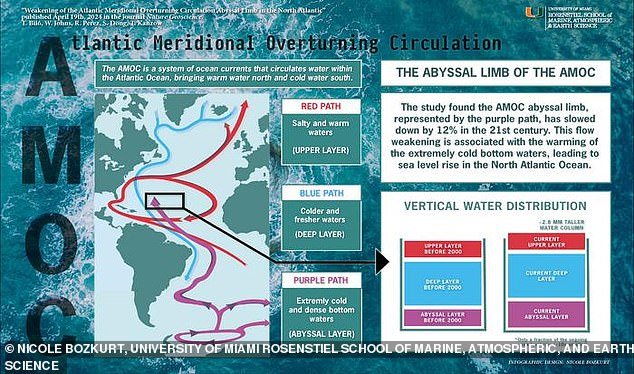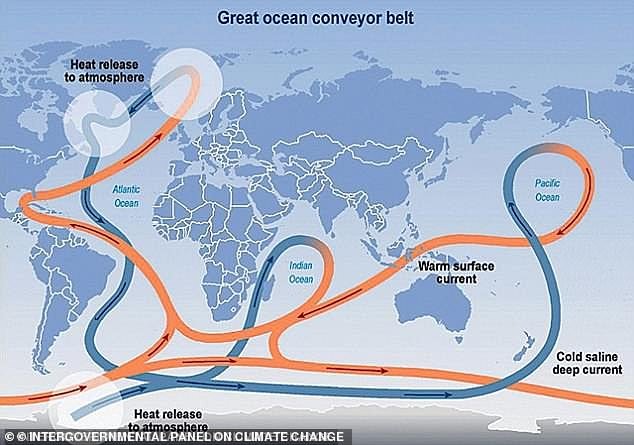US east coast is at greater risk of flooding – thanks to ‘dangerously weak’ Atlantic Ocean currents, top scientists warn
The US East Coast is predicted to experience rising sea levels in the coming decades, but a new discovery could accelerate the timeline.
Researchers from the University of Miami have found that a critical ocean current that brings cool water from around Antarctica to the North Atlantic Ocean slowed by 12 percent between 2000 and 2020, but is expected to decline to 15 percent by 2050.
The weakening current – called the abyssal limb – is part of the Atlantic Meridional Overturning Circulation (AMOC), a system of ocean currents that acts as a ‘conveyor belt’ to spread heat, nutrients and carbon dioxide across our oceans.
Because cooler water does not flow abundantly into the North Atlantic Ocean, ocean temperatures will rise and cause the water to expand, putting millions of Americans at risk of coastal flooding.
The US East Coast is predicted to experience rising sea levels in the coming decades, but a new discovery could accelerate the timeline. Pictured is Seaside Park, New Jersey, as Storm Ophelia struck in 2023
Tiago Bilo, lead author of the study, said in a rack: ‘Although this number may seem small, the areas affected by this warming span thousands of kilometers in the north-south and east-west directions in the deep sea (4.5 – 6.7 miles depth).
‘As a result, there is a significant increase in the heat content of the deep sea ocean, which contributes to local sea level rise due to the thermal expansion of the water.’
Biló further explained that the weakening between 2000 and 2020 caused sea levels to rise by 2.8 millimeters.
Scientists have long studied AMOC for fear that it could collapse, but even weakening could change weather patterns, affect marine life, change temperatures and increase flooding.
The current has several layers – upper, deep and abyssal – that move water around the world.
The upper layer transports warm water from the subtropical South Atlantic Ocean across the equator northward to high latitudes in the North Atlantic Ocean, where it cools, sinks, and flows toward the equator as cold deep water.
The abyss carries denser water from Antarctica’s ice edge, which flows north along the seafloor to the North Atlantic Ocean, where it slowly rises and mixes with other water flowing back south.

The weakening current – called the abyssal limb – is part of the Atlantic Meridional Overturning Circulation (AMOC), a system of ocean currents that acts as a ‘conveyor belt’ to spread heat, nutrients and carbon dioxide across our oceans.

Scientists have long studied AMOC over fears that it could collapse, but even weakening could change weather patterns, affect marine life, change temperatures and increase flooding.
The deep-ocean current includes Antarctic Bottom Water (ABW), which is created by the cooling of seawater in the Southern Ocean around Antarctica during the winter months.
ABW sinks to the ocean floor and moves north, driving the AMOC abyss.
The researchers collaborated with the National Oceanic and Atmospheric Administration (NOAA) on the study, which was conducted using two decades of oceanographic data collected by observational mooring programs.
A mooring is a collection of devices connected to a ship and anchored to the seabed.
The data allowed the team to see how the ABW stuck around Antarctica could affect the North Atlantic Ocean.
‘Although these regions are tens of thousands of kilometers apart and abyssal regions lie a few kilometers below the ocean surface, our results reinforce the idea that even the most remote areas of the world’s oceans are not untouched by human activity’ Biló.
Climate scientists have long been sounding the alarm about rising sea levels along the American east coast.
The New York City Panel on Climate Change (NPCC) claimed in January that sea levels around New York City could rise by three feet in the 2030s, leading to tropical storms and higher temperatures.
NOAA found in 2022 that more than 56 million people living along the U.S. East Coast and the Gulf of Mexico are expected to experience at least ten times as many days of high tide flooding by 2050 due to rising sea levels caused by climate change.
